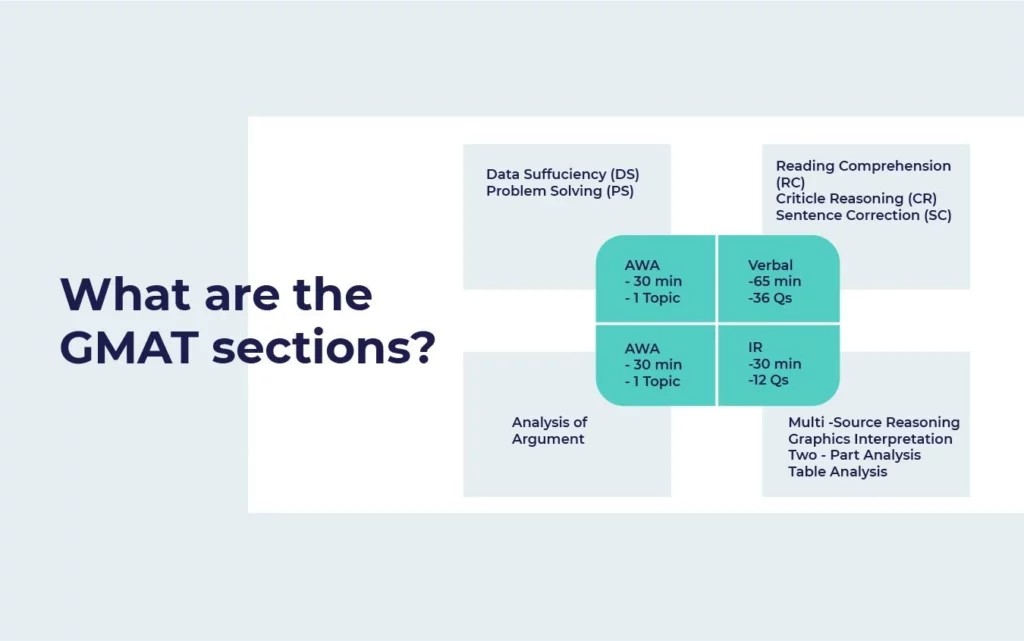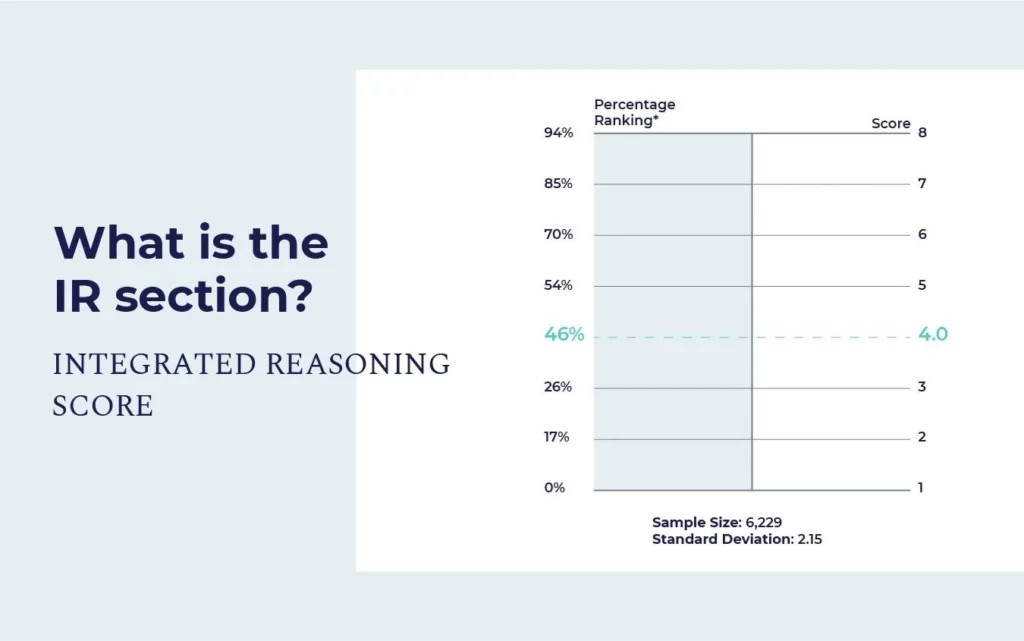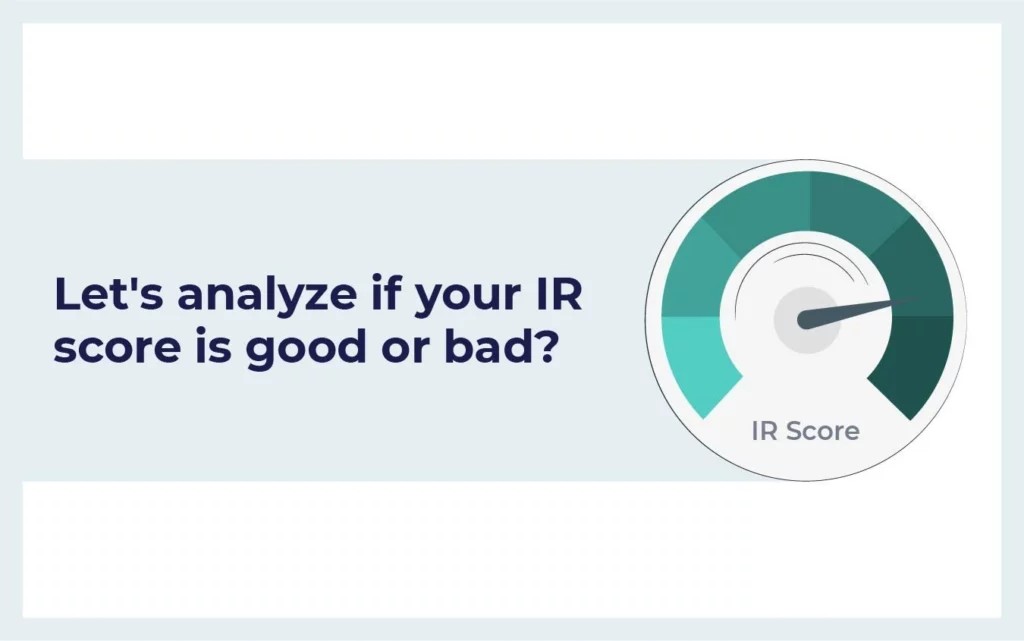For many prospective MBA students, the GMAT Integrated Reasoning (IR) section can feel like a mysterious component of the application puzzle. Questions like “Is the GMAT IR section difficult?” and, more importantly, “Do Mba Programs Care About Integrated Reasoning scores?” are frequently asked. It’s crucial to understand what IR is and how it truly impacts your MBA application. Let’s delve into the significance of the Integrated Reasoning section and its role in the eyes of top business schools.
The GMAT exam has evolved to reflect the demands of modern business education, which is increasingly data-driven. Business schools utilize the Integrated Reasoning section to assess an applicant’s ability to navigate and analyze complex data – a skill vital for success in today’s challenging business landscape. While the GMAT score still comprises the traditional Quantitative and Verbal sections, with a separate score for Analytical Writing Assessment (AWA), the IR section is also scored independently on a scale of 1-8. But does this separate score truly matter to admissions committees?
In short, yes. While in the past, the IR section might have been considered less critical, its importance has grown significantly. As industries become more reliant on data for strategic decision-making, business schools are actively seeking candidates who demonstrate strong analytical and problem-solving skills in data-rich environments. This is precisely what the Integrated Reasoning section is designed to evaluate. It’s about gauging your ability to think quickly, assess risks, and make informed decisions based on complex information – skills that are highly valued in the real world and within MBA programs.
Here’s a roadmap of what we’ll cover in this article to give you a comprehensive understanding:
- Breaking Down the GMAT Sections
- In-depth Look at the GMAT Structure
- What Exactly is the Integrated Reasoning Section?
- The Growing Importance of the IR Score for MBA Admissions
- Impact of a Low IR Score with a High Overall GMAT
- Strategies to Enhance Your IR Performance
- Defining a Good IR Score for MBA Applications
- Frequently Asked Questions About the GMAT IR Section
Breaking Down the GMAT Sections
The Graduate Management Admission Test (GMAT) is a standardized assessment widely used by business schools globally as a predictor of academic success in MBA and other business master’s programs. It provides a consistent benchmark of essential academic skills, enabling admissions committees to effectively compare applicants from diverse educational and professional backgrounds.
The GMAT exam evaluates skills critical for graduate-level business education through four distinct sections:
- Analytical Writing Assessment (AWA): Measures critical thinking and written communication skills.
- Verbal Reasoning: Assesses reading comprehension, critical reasoning, and grammar/editing skills in written English.
- Quantitative Reasoning: Evaluates the ability to analyze data, solve problems using mathematical concepts, and interpret quantitative information.
- Integrated Reasoning (IR): Tests the ability to synthesize information presented in multiple formats and solve complex problems using data from various sources.
In-depth Look at the GMAT Structure
Let’s examine each GMAT section in more detail:
-
Analytical Writing Assessment (AWA): This section requires you to analyze an argument and articulate your evaluation in a well-structured essay. It assesses your critical thinking and ability to communicate complex ideas in writing.
-
Verbal Reasoning: This section tests your comprehension of written material, your ability to evaluate arguments, and your command of standard written English. It includes Reading Comprehension, Critical Reasoning, and Sentence Correction question types.
-
Quantitative Reasoning: This section focuses on your ability to reason quantitatively and solve problems using mathematical concepts. It includes Problem Solving and Data Sufficiency question types, covering areas like arithmetic, algebra, and geometry.
-
Integrated Reasoning: This section is designed to evaluate your ability to analyze data presented in various formats, such as tables, graphs, and text passages, and synthesize information to solve multi-faceted problems.
GMAT Scoring and Marks Distribution
Understanding the scoring system is key to appreciating how each section contributes to your overall GMAT profile:
| Section | Score Range | Scoring Method |
|---|---|---|
| Analytical Writing Assessment | 0.0-6.0 | Essays are evaluated by both professional essay raters and a computer algorithm. Scores are reported in 0.5-point increments. |
| Integrated Reasoning | 1-8 | Your IR score is determined by the number of questions you answer correctly. Some questions have multiple parts, and you must answer all parts correctly to receive credit for the question. Scores are reported in 1-point increments. |
| Quantitative and Verbal Reasoning | 6-51 | The Quantitative and Verbal Reasoning sections are section-adaptive. Your score is based on: 1. The number of questions answered. 2. The accuracy of your answers. 3. The difficulty level of the questions you answered, among other factors. Answering more questions correctly and tackling more difficult questions leads to a higher score. Scores are reported in 1-point increments, with a standard error of measurement of approximately 3 points. |
| Total GMAT Score | 200-800 | The Total GMAT score is derived from your performance on the Quantitative and Verbal Reasoning sections. The raw scores are converted to a scaled score within the 200-800 range. Scores are reported in 10-point increments. The standard error of measurement for the Total Score is approximately 30-40 points. |







Achieving a strong GMAT score is a significant step toward gaining admission to a top business school. A competitive GMAT score not only demonstrates your academic capabilities but also reassures admissions committees of your preparedness for the rigors of an MBA program.
For further insights into score expectations at leading institutions, explore our article on Average GMAT scores for top MBA programs – US, Europe, Canada.
Unsure if your profile is competitive for your target MBA programs?
Connect with our expert MBA admissions consultants for a FREE PROFILE ANALYSIS and gain clarity on your chances of admission.
What Exactly is the Integrated Reasoning Section?
The GMAT Integrated Reasoning (IR) section is specifically designed to assess your ability to evaluate data and information from multiple sources to solve complex problems. Business schools recognize that in today’s data-rich business environment, the ability to synthesize information from various formats and make sound judgments is paramount. The IR score provides a measure of this crucial skill set.
The GMAT IR section evaluates four key skill areas:
- Analyzing Data from Multiple Sources: The section presents information in diverse formats, including tables, graphs, and text passages, requiring you to integrate information from different sources to reach conclusions.
- Table Analysis: These questions require you to analyze and interpret data presented in tabular format, often resembling spreadsheets, and extract relevant insights.
- Graphics Interpretation: You’ll need to interpret data visualized in various graphical formats, such as scatter plots, bar charts, pie charts, and line graphs, and draw conclusions based on your analysis.
- Two-Part Analysis: These questions present complex problems that often involve simultaneous relationships or equations. You must analyze the problem and select the correct answers from two columns of options, demonstrating your problem-solving and analytical abilities. It’s important to note that partial credit is not awarded in Two-Part Analysis questions; both parts must be answered correctly to receive credit.
The IR section consists of 12 questions to be completed within a 30-minute timeframe.
| Question Type | Description |
|---|---|
| Graphic Interpretation | Requires interpretation of data presented in visual formats like scatter plots, x/y graphs, bar charts, pie charts, and statistical curves to derive solutions. |
| Table Analysis | Involves analyzing and interpreting data presented in tables or spreadsheets to extract practical knowledge and insights. |
| Multi-Source Reasoning | Presents information from multiple sources (text passages, tables, graphs) that need to be analyzed together to identify relevant data, draw conclusions, and answer questions based on the integrated information. |
| Two-Part Analysis | Tests the ability to solve complex problems and simultaneous equations to determine the relationship between different aspects of the problem. |
The Growing Importance of the IR Score for MBA Admissions
When the Integrated Reasoning section was introduced in 2012, business schools were initially cautious in their approach to evaluating IR scores. Early responses ranged from stating they were not yet evaluating IR due to limited data to indicating they were considering all aspects of the GMAT comprehensively. Fast forward to today, and the landscape has shifted significantly. Now, many leading business schools explicitly state that they seriously consider the IR score as part of their admissions process.
So, why does Integrated Reasoning matter to MBA programs?
- Demonstrates Quick Thinking and Problem-Solving: The IR section directly assesses your capacity for rapid analysis and effective problem-solving in data-rich scenarios.
- Combines Verbal and Quantitative Reasoning Skills: IR effectively bridges the gap between verbal and quantitative skills, requiring you to integrate both to analyze complex information and arrive at logical conclusions.
- Tests Practical Application in Real-World Situations: The IR section is designed to simulate real-world business challenges where professionals must quickly process and synthesize information from diverse sources to make informed decisions.
- Reflects Industry Demands: Business schools and corporations increasingly value the ability to handle real-world data effectively. Companies across industries need professionals who can quickly analyze data, identify trends, and make strategic decisions based on evidence. Leading consulting firms, for instance, are recognizing the importance of IR skills and may even start requesting IR scores alongside traditional GMAT section scores.
In today’s fast-paced business environment, rapid and effective decision-making is paramount. The Integrated Reasoning section of the GMAT is becoming an increasingly important indicator of a candidate’s readiness to thrive in this demanding landscape, making it a relevant factor in MBA admissions.
Strategies to Enhance Your IR Performance
Improving your GMAT Integrated Reasoning score requires a focused approach. Here are key strategies to help you excel in this section:
-
Focus on Data Analysis and Interpretation: Don’t rush through the questions. Take your time to thoroughly understand the question and the data presented, even if it means re-reading. Ensure you fully grasp what the question is asking. The IR section is designed to be challenging, but all the necessary information to answer the questions is provided. Analyze each data source carefully, as the questions demand a comprehensive understanding of the information given.
-
Avoid Assumptions and Prior Knowledge: Do not let any pre-existing knowledge or assumptions influence your responses. Focus solely on the information presented within the question itself. If information is not explicitly provided, consider it irrelevant. Instead, concentrate on understanding how different pieces of information within the question relate to each other. Many questions will require you to draw conclusions based on specific relationships within the given data.
-
Evaluate All Answer Options: Carefully review all available answer options. This can often help you clarify the question and eliminate incorrect choices. Sorting through extraneous data to identify vital information is crucial. The GMAT IR section often presents a significant amount of information, some of which may be irrelevant to the question at hand. Part of the test is your ability to discern which parts of charts, tables, graphs, etc., are pertinent to answering the specific question.
Defining a Good IR Score for MBA Applications
While the average score on the IR section is around 4, aiming for a score of 5 or higher out of 8 is generally considered a good target for MBA applicants seeking an edge. A score of 5 or above can position you favorably compared to other applicants and demonstrate a solid competency in data analysis and integrated reasoning.
Impact of a Low IR Score with a High Overall GMAT
It’s important to recognize that while the Analytical Writing Assessment (AWA) and Integrated Reasoning sections do not contribute to your overall 800-point GMAT score, they are still significant components of your application profile. A well-rounded application considers performance across all GMAT sections.
In today’s competitive business world, quick thinking and effective problem-solving are highly valued. Businesses face a multitude of challenges daily, and employers, especially leadership, need to remain composed and perform effectively under pressure. The Integrated Reasoning section provides business schools with insights into these critical abilities.
The IR section is increasingly becoming a differentiator in the MBA admissions process. While a high overall GMAT score remains crucial, it’s no longer the sole determinant of success. Admissions committees are now evaluating the IR score alongside other section scores like AWA, Verbal, and Quantitative. In cases where candidates have similar overall GMAT scores, a strong IR score can be the deciding factor. Business schools are looking for well-rounded individuals, not just those who excel in traditional quant or verbal skills. A balanced scorecard across all GMAT sections is key.
Consider this scenario:
Two candidates are vying for the last two spots in an MBA program.
- Candidate A: Quantitative Score 48 / IR Score 8
- Candidate B: Quantitative Score 50 / IR Score 4
In this competitive situation, Candidate A is likely to have an advantage. While Candidate B scores slightly higher in the quantitative section, Candidate A’s exceptional IR score demonstrates a well-rounded skillset that business schools increasingly value. Schools prefer candidates who exhibit strength across multiple dimensions, highlighting the importance of a balanced GMAT performance.
The emphasis here is on reasoning. The GMAT, from its inception, has aimed to evaluate higher-order reasoning abilities. The IR section is a modern extension of this focus, assessing your ability to reason with complex data in a business context.
While the IR section provides an on-screen calculator, don’t anticipate overly complex mathematical computations. The difficulty level of the math itself remains consistent with the quantitative section. Since the IR section is not adaptive, you will encounter a mix of question difficulties – easy, medium, and hard. Maintaining focus and sharp analytical skills throughout the section is crucial.
Feeling apprehensive about the GMAT’s Integrated Reasoning section? Don’t worry! Our expert consultants can develop personalized strategies to help you master the IR and all other sections of the GMAT. Schedule a consultation today and gain valuable insights to excel on the IR section and stand out in a competitive applicant pool.
SUBMIT A PROFILE EVALUATION REQUEST
Frequently Asked Questions About the GMAT IR Section
01. Does the IR score affect the overall GMAT score?
No, the Integrated Reasoning score is reported separately and does not contribute to your overall GMAT score out of 800. The IR score is an independent assessment of your data analysis and reasoning abilities.
02. Does a low IR score matter for MBA applications?
Yes, a low IR score can matter, especially at top MBA programs. While your overall GMAT score is still highly important, business schools are increasingly considering the IR score as an indicator of your ability to handle data-driven decision-making. GMAC research indicates that IR scores are strongly correlated with first-year MBA grades, even more so than the Quantitative, Verbal, or overall GMAT scores.
03. How difficult is the GMAT IR section?
The IR section is designed to be challenging, but it is not adaptive, meaning you will encounter a mix of easy, medium, and difficult questions. Success in the IR section relies on strong analytical skills, data interpretation abilities, and effective time management.